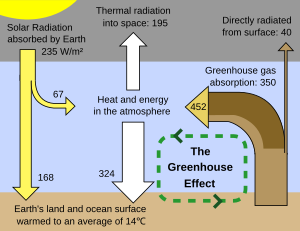 |
| The greenhouse effect (Photo credit: Wikipedia) |
The next generation will be the ones to feel the increasing effects of climate change. But how much do they really know about it?
After all, it’s one thing to say: yes, I believe in climate change. But another to say: yes, I understand it and how it works.
There is a lot of research which supports the idea that until a person understands the science behind climate change, they may not support political regulation or make personal decisions to help reduce greenhouse gas production.
Our new study, published in the latest edition of Teaching Science, has investigated the scientific understanding of 438 Western Australian Year 10 students in relation to the greenhouse effect and climate change. The results are startling.
What we know they know
When asked for a written response to the question “what is climate change?” only half of the students gave an answer which showed some understanding of the science behind climate change. Furthermore, one-third of the students included some type of alternative conception in their answer.
When answering the question “what is the greenhouse effect?” the results were even more disappointing with only one third of students able to provide an answer showing some understanding of the science behind the greenhouse effect. Over 40% of the answers included at least one alternative conception.
So what does this mean? Well, on the surface, the results obviously show that the majority of Year 10 students do not understand the science behind the greenhouse effect and climate change.
However if you look deeper, it is their alternative conceptions that reveal how misunderstanding climate change science can affect the decisions students make.
Mysteries and misconceptions
The most common misunderstanding we found was confusing the ozone layer with the greenhouse effect.
This is also common in the general population and is completely understandable, given that the purpose of both is to protect the Earth from ultraviolet rays in one case, and infrared rays in the other.
The problem is that chlorofluorocarbons (CFCs) are associated with the degradation of the ozone layer, whereas greenhouse gases, such as carbon dioxide, are involved in the enhanced greenhouse effect which contributes to global warming.
This is an important distinction because the moderating behaviour is different for each. To protect the ozone layer we need to decrease the escape of CFCs, still found in air conditioners and refrigerators. The release of one chlorine atom can destroy over 100,000 ozone molecules.
But to mitigate the consequences of the enhanced greenhouse effect, we need to reduce our energy usage in all its varied forms or invest in low emissions technology.
Our study also found up to 15% of students thought carbon dioxide was the only greenhouse gas. This really isn’t surprising given the focus carbon receives in our debate on climate change. After all, the media talks mostly about “carbon taxes” and “carbon footprints”.
It’s good there is some knowledge there, but this study shows it remains incomplete. And without the basic scientific understanding, students and the public in general do not fully understand the consequences of their decisions.
Water (the most abundant greenhouse gas), methane and nitrous oxide are all important contributors to the enhanced greenhouse gas and are affected by human activity. Methane in particular contributes to the enhanced greenhouse effect and is 21 times more potent than carbon dioxide.
It is important then for meat and dairy eaters to recognise that livestock (mostly cattle) are responsible for up to 20% of the world’s methane production. Farmers and scientists are currently investigating steps which can be taken to try and reduce this percentage.
What can be done?
So where do these misunderstandings spring from? And what can we do to improve young people’s information on climate change?
There are several problems with the way science is taught in Australian schools that makes improving young people’s understanding difficult.
To start with, climate change is not explicitly mentioned in the Australian Curriculum in Science until year 10, despite young people’s exposure to the topic in the media much earlier.
In fact, the results of our survey showed that TV was the most frequent source of information about climate change, with school science coming second (although school science was seen as the most trustworthy).
Then there’s the fact that climate change science is multidisciplinary, drawing from chemistry, physics, biology and earth sciences.
Even the recent Australian curriculum divides science into four discrete sections, which means young people are not able to make the links between the scientific aspects of climate change.
The fact that climate science is sometimes seen as a socio-scientific issue is also problematic. It means that some don’t see it as a legitimate topic for school.
And finally, young people are failing to select science in the final two years of secondary school thus depriving them of the opportunity to examine these types of issues in depth.
If we want to improve this situation, it needs to begin in school with a curriculum which promotes understanding of climate science as well as pro-environmental behaviour. Teachers need to be aware of common alternative conceptions (often held by teachers themselves) and be given the resources and skills to overcome them.
But without addressing this, through better education, we may see the current apathy around climate change, continue into the next generation.
Vaille Dawson receives funding from the Australian Research Council.
Katherine Carson does not work for, consult to, own shares in or receive funding from any company or organisation that would benefit from this article, and has no relevant affiliations.
This article was originally published at The Conversation. Read the original article.

No comments:
Post a Comment